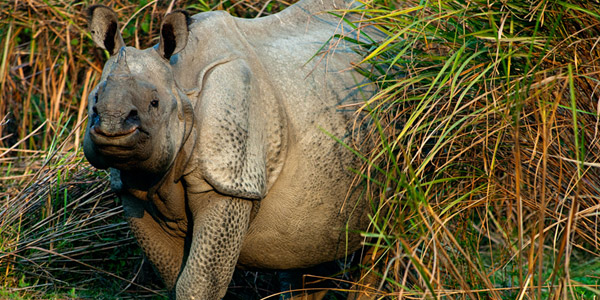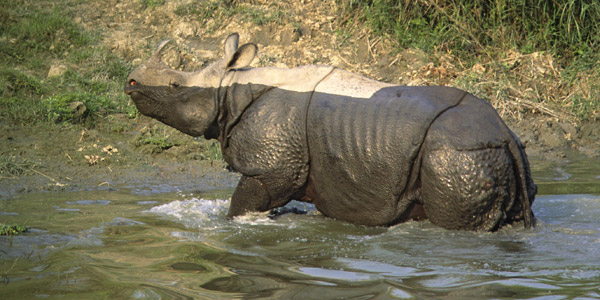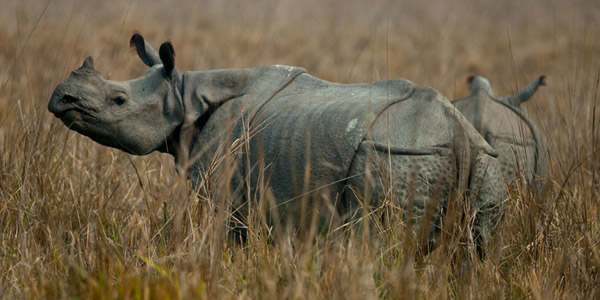The Upside for Indian Rhinos

The past year will go down as one of the darkest on record for rhinos. We can’t ignore this unfortunate truth.
But amidst all the bad news, there remain glimmers of hope that strengthen our resolve to ensure the survival of rhinos across the globe.
Leading up to the year’s end, we’re going to be sharing stories of rhino conservation that’s working. We’re taking time to celebrate the small victories won by our projects in Africa and Asia, which inspire hope for the future of rhinos.

Have you heard the story of the Indian rhino? Down to fewer than 200 animals at the turn of the last century, the incredible comeback of this species proves that with adequate government commitment, protection and habitat, rhino populations can grow.
Since 2007, Indian rhino numbers have increased from about 2,575 to more than 3,333 — a 30% increase in only 7 years!
India’s state of Assam holds about 2,200 rhinos. But, in the late 1990s, it was the scene of political turmoil that led to the loss of the species in several areas. In addition to protecting current populations, the species’ full recovery will depend on reintroducing them throughout their previous range. That’s the goal of Indian Rhino Vision 2020 implemented by the International Rhino Foundation and partners. In numerical terms,Indian Rhino Vision 2020 aims to increase Assam’s rhino population to 3,000 by the year 2020 — requiring an increase of around 500 animals in the next 6 years.
Together, we can make bring this vision to light.

Indian Rhino Vision 2020 calls for re-establishing populations by translocating animals from protected areas that are bursting at the seams with rhinos, such as Pobitora Wildlife Sanctuary and Kaziranga National Park. IRF and partners have moved animals from both Pobitora and Kaziranga west to Manas National Park, from which rhinos were extirpated during civil strife in the late 1990s.
The good news is that about two dozen animals have been moved, several of them rescued after seasonal floods. Eleven calves have been born since the reintroduction program began in 2008.
The bad news is that Manas has been hard-hit by poaching, losing 8 adult animals with most in 2013. The last three losses are attributed to a recent insurgency movement. Despite obstacles, Manas’ 668 square miles (95,000 ha) offers the largest land area and best habitat for rhino translocations. If poaching is contained, the 30 animals living there will thrive.
IRF and partners convened a meeting last month in India to discuss options for Manas. Park authorities and government are committed to bringing the poaching situation under control. But we need confidence that the park’s protection has significantly improved before planning any additional translocations to Manas.
In the meantime, we are preparing to return rhinos to the Burachapori-Laokhowa Wildlife Sanctuary in early 2015. Burachapori-Laokhowa is very near Kaziranga and, with Orang National Park, will be part of a future rhino corridor. Like Manas, Burachapori-Laokhowa once held rhinos before they poached out during civil unrest. The rhinos’ disappearance there, however, took place more than 30 years ago.
We know that Indian Rhino Vision 2020 is an ambitious program. We’re remaining optimistic and learning as we go. We’re building the lessons from Manas into the next translocations.

This time, the rhinos will be contained in a very large boma (pen) prior to release into the sanctuary. For Indian Rhino Vision 2020 to be successful, local people must benefit from the presence of rhinos. We’re working with partners to implement awareness and livelihood programs to create value for local communities.
You can help us cast the light of hope on Indian Rhino Vision 2020.
We need your help to build shelters and perimeter fences, train and equip guards, and move the rhinos from Kaziranga once their new home is ready.
Every gift, small or large, helps. Every gift allows us to do more.

